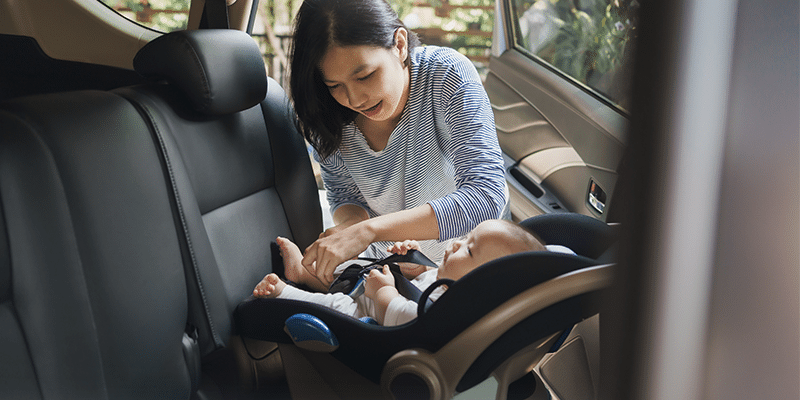NEW MICHIGAN CAR SEAT LAWS
Car accidents are the leading cause of death for children under 13, according to data from Michigan State Police. The good news is that using the proper car seat, booster seat or seat belt can help reduce this risk by 50 percent. Effective April 2, 2025, new Michigan car seat laws increase protection for the youngest, most vulnerable passengers. Unfortunately, the most stringent safety precautions cannot prevent every accident. If you or a loved one is injured, hiring an experienced Michigan car accident attorney is the best way to protect your rights and receive the compensation you deserve.
WHAT IS INCLUDED IN THE NEW MICHIGAN CAR SEAT LAWS?
In addition to requiring that children be secured in a car seat or booster seat appropriate for their age, weight and height according to instructions from the car seat’s manufacturer, the new laws include specific changes for transporting young passengers
Here is a summary of the updated car seat laws that take effect April 2, 2025:
Infants – two years
Infants and toddlers must be in a rear-facing car seat until they reach the maximum weight or height allowed by the car seat’s manufacturer or turn two years old, whichever occurs first.
Under the old law, only children under the age of one had to ride in rear-facing car seats.
Two – five years
Children should use a forward-facing car seat with an internal harness until they reach the maximum weight or height allowed by the car seat manufacturer or turn five years old, whichever occurs first.
The previous law required the use of forward-facing car seats for children up to the age of four.
Five – eight years
Children should use a belt-positioning booster seat using a lap-and-shoulder belt until they are 4 ft., 9 in. tall or turn eight years old, whichever occurs first.
All children under 13
Children must use seat belts after they have outgrown the height and weight limits of their booster seat. For maximum protection, children should use the lap/shoulder belt rather than the lap-only belt found in the back seats of certain vehicles.
In addition, any passenger under the age of 13 should ride in the rear seat of a vehicle whenever possible.
WHAT IF A REAR SEAT IS NOT AVAILABLE?
If all available rear seats are occupied by children under four, then passengers under four may ride in the front seat using the appropriate car seat or booster for their height, weight and age.
When transporting young children in a vehicle that does not have a back seat, such as a pick-up truck, children may ride in the front seat using the appropriate car seat or booster for their height, weight and age.
However, the airbag must be turned off whenever a child in a rear-facing car seat rides in the front seat.
DO MICHIGAN CAR SEAT LAWS APPLY TO TRUCKS AND SUVS?
Yes. These updated laws apply to all passenger vehicles, including trucks and SUVs.
MAKE SURE YOUR CAR SEAT IS PROPERLY INSTALLED
More than 70 percent of car seats are improperly installed, which means they cannot provide adequate protection in the event of a crash.
Here are some of the most common installation mistakes:
- Loose harness straps
- Straps should fit snugly against the child so there is no slack when straps are fastened
- Car seat is not fastened securely in the vehicle
- You should not be able to move a car seat more than one inch from either side at the point where the seat attaches to the vehicle
- Using a seat that is the wrong size or style
- Use the car seat that is appropriate for the height, weight or age limits specified by the manufacturer
- Improperly positioned chest clip
- Secure the chest clip level with the child’s armpits to ensure straps remain in the correct position
- Putting kids in the front seat too early
- If a crash occurs, children under 13 can be seriously hurt by the force of an air bag
NOTE: Michigan police and fire stations provide free assistance installing car seats or determining whether they comply with current Michigan law. More information on child passenger safety is also available at Michigan.gov/carseats.
BE A GOOD ROLE MODEL: WEAR YOUR SEAT BELT AND AVOID DISTRACTIONS
Actions speak louder than words, especially to children, who learn by example. When adults practice safe driving protocols, teens and young adults are more likely to follow suit.
Here are some ways to encourage young passengers to use seat belts:
- Clearly communicate the safety rules for riding in a car
- Praise children for positive behavior
- Demonstrate safe driving habits by using seat belts and avoiding distractions
- Explain the importance of wearing seat belts even on short trips
- Teach older children to wear seat belts in the back seat, even after they exceed the legal requirement (16 and older)
CALL OUR EXPERIENCED CAR ACCIDENT ATTORNEYS TO WIN THE COMPENSATION YOU DESERVE
If you or a family member was injured in an auto accident, contact us immediately. Our knowledgeable legal team knows what it takes to win your case, and we have the expertise and resources to fight for the compensation you deserve.
Michigan car accident laws are complicated, but finding the right auto accident attorney is simple.
Click the button below to fill out a brief form or call 1-800-CALL-SAM for a free, no-obligation consultation with a member of our legal team.
HAVE YOU BEEN INJURED?
Get The Bernstein Advantage® today!
Free. Simple. Quick.


